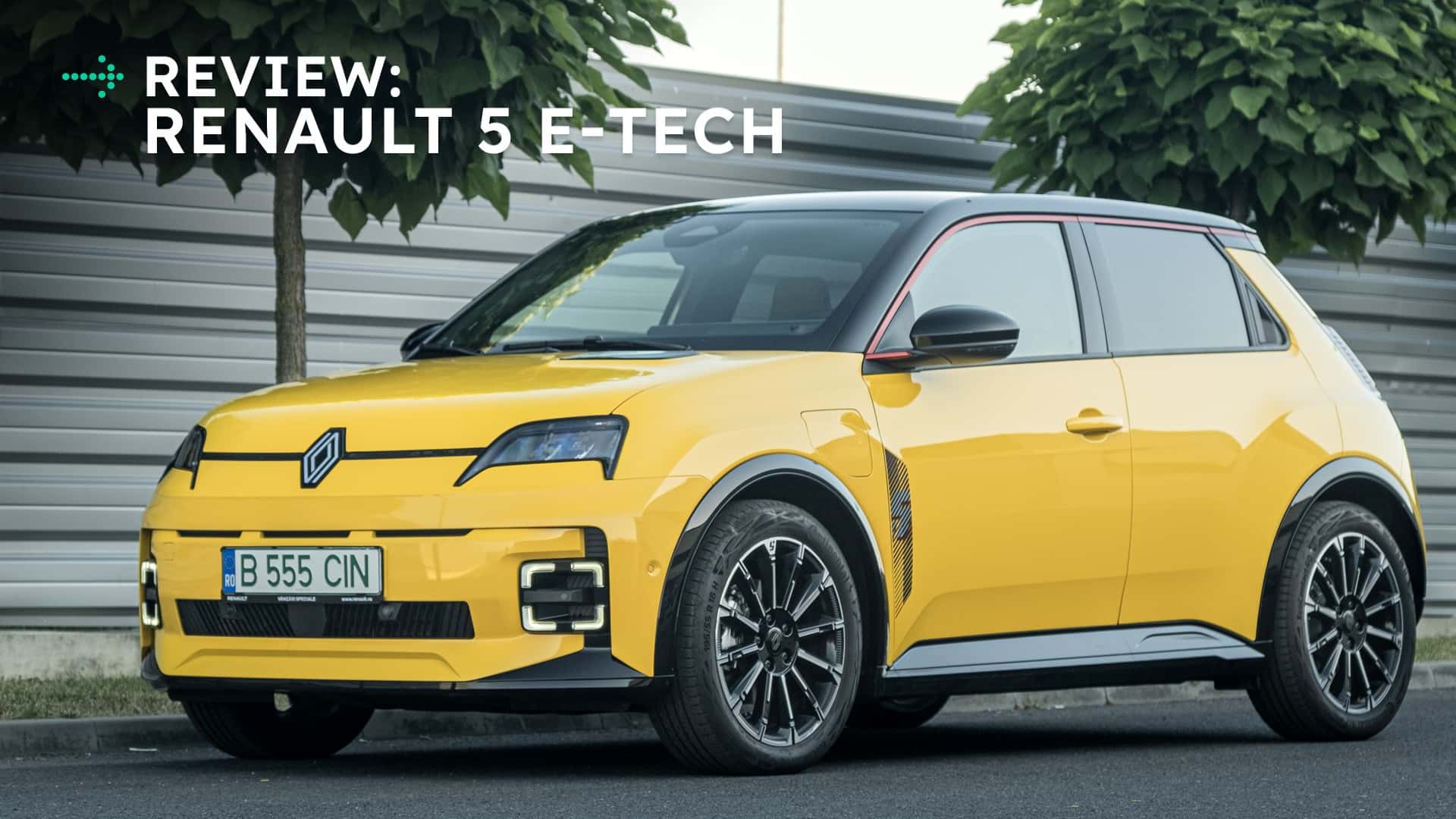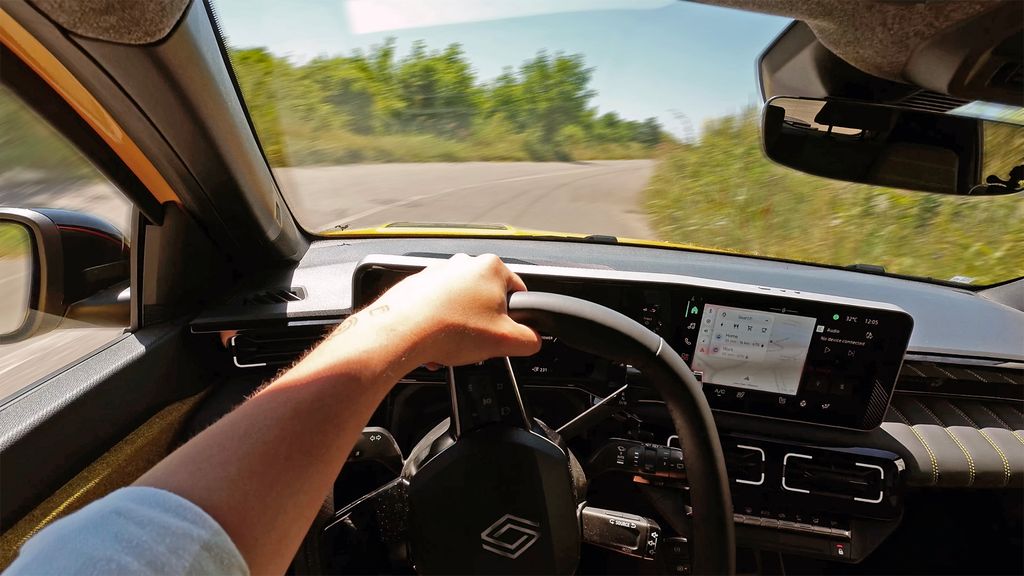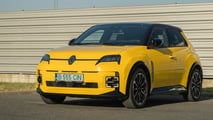
The way it looks is reason enough to buy the Renault 5 E-Tech. It looks like the result of tossing several classic Renault hatchbacks into a blender with some sci-fi gravy. It somehow ends up being a really tasty combo, but what clinched it for me was that it drives with enough poise and gusto to challenge a Mini Cooper E.
It strikes a better balance between sporty handling and comfort than the new Chinese-built Mini J01, which feels too stiff in comparison. Like the Mini, the R5 has a multilink independent rear suspension setup, which you rarely see in this segment of the market, making it feel surprisingly sophisticated as it glides over road imperfections. Oh, how very French of it.

This is one of the few electric cars that should come close to matching its WLTP range thanks to its consistently impressive efficiency, even when you’re not trying to save electrons. It’s nice to look at, pleasant to travel in, and the user experience is especially impressive.
It’s not perfect, though, since the version you want, with the more powerful motor and bigger battery, is not cheap, and there’s no room for a rear passenger sitting behind taller drivers. But if you accept that it’s pitched as a somewhat premium product (hence the price) and keep the hauling of big groups to a minimum, it all starts to make sense.
Tron Meets Baguette

Few cars blend retro design cues into a fresh, cohesive and modern look quite like the Renault 5. It’s like something you would see in a sci-fi movie with its holographic-looking, squared-off daytime running lights and matching squares in the headlight glass.
One of my favorite details is the 5 on the left side of the hood, which mimics the placement of an actual vent in the classic Renault 5, which was sold as the LeCar in the United States. The 5 even lights up in higher-spec versions like my tester, where it also acts as a battery meter to tell you the state of charge from a distance.
It also plays a cool animation when the car unlocks, and it makes you feel pretty special. It may seem trivial, but the light-up 5 is a must-have option for this car. I also really like the design of the rear lights, which, just like in the classic 5, run up the C-pillar. They have a cool 3D effect and built-in fake vents, which are meant to resemble the ones on the mid-engined Renault 5 Turbo rally homologation special. The Turbo is coming back with electric power, featuring in-wheel electric motors.


There are plenty of cool details all around the vehicle, and they all blend really well with the overall design. Nothing feels forced or like an afterthought on this.
Wheel design isn’t something I normally feel the need to mention in a review, but I have to because all the available options for the Renault 5 are fantastic. Even the base model’s hubcaps have aesthetic appeal, likely also helped by the fact that all wheel choices are quite big for a car this size at 18 inches—even the steelies.
An ‘80s Arcade Machine That You Can Sit In

The interior perfectly matches the exterior for style, with the same kind of retro-futuristic approach. This is the first car I’ve been in recently where thick bezels around the displays look like a smart design choice and not the result of the manufacturer installing screens smaller than they should be and trying to make them look big.
The top of the gear selector is translucent and has the Renault logo inside, which looks really fancy. Putting it in gear and using any of the stalks, I was impressed by how solid, damped and expensive they felt. The steering wheel looks great and is fantastic to hold on to. It’s probably one of my favorite helms in a modern car.
The seats also deserve a mention. They’re trimmed in something that feels like denim with a mustard yellow color that seems ripped out of a 1970s design magazine. The chairs themselves are soft, supportive and utterly French in the best possible way. They look fantastic and appear modeled after the Turbo 2 seats.



This is also the first modern car where thick bezels around the screens didn’t make it look cheap. Quite the opposite, actually. The driver gets a 10.1-inch display behind the steering wheel, while there’s another 10-inch screen in the middle handling infotainment. It’s among the best I’ve ever used in a car. We’ll get to that shortly.
The user experience inside the R5 is also really good, thanks to a brand-new infotainment operating system built around Android Automotive. I’ve met actual people less responsive than its artificial intelligence-powered digital assistants. Chatting to the bot is surprisingly natural, making asking it questions a lot less awkward than in other cars.
As much as I loved the R5’s interior, it’s not quite perfect. While I praised the overall build quality, there were a couple of spots where the plastic panels didn’t join together perfectly, and the ergonomics are a bit odd, too. To the right of the steering wheel, you have three stalks. One handles the transmission, another the wipers and that’s just too much to remember the position of on one side of the wheel.

There’s also no ‘Park’ position for the transmission, so when you want to stop, you put the car in neutral and then extend your arm all the way to the nether reaches of the dashboard to pull the parking brake button. Then again, a French car without a little weirdness would be an incomplete product.
But another issue I have with the R5 is the shameful lack of rear legroom. With the driver’s seat set for a six-footer like myself, there is no room for a full-size adult to sit behind the driver. There’s just no space for their feet, which makes the car more of a 3+1 rather than a true four-seater. This doesn’t make me like it less, since it’s about the same as a Mini J01, but it could have been a bit better. Maybe Renault could have sacrificed some trunk space for a bit of extra rear leg and foot room.
Corners Like It Means It, But Softly

What really won me over is how it drives. The steering is sharp without being twitchy, and when you tip it into a corner, it weights up nicely and gives you a lot of confidence. That may seem secondary for a car that will spend most of its time sitting bumper-to-bumper in a crowded city. But it is this responsiveness that made me (and many others) like old Renault Clios, so I was very happy to see this character transferred to the new EV.
The well-judged suspension also deserves a mention. It’s a bit softer than in the Mini J01, but it’s all the better for it, since it has a smoother ride over uneven roads. The multilink rear suspension really helps when going over big imperfections or over the wildly inconsistent tram tracks that we have here in Bucharest. Almost no subcompact cars these days have independent rear suspension—it’s kind of a premium feature—making it clear what Renault is aiming for with the R5.
Taking it out on some more windy country roads, the R5 never felt flustered. Carry a bit too much speed into a corner, lift off just before hitting the apex and you feel it rotating around you, like a proper hot hatch should. This isn’t just competent. It’s fun, and I can’t say that about too many EVs in its price, power and size bracket.

My tester had the beefier motor. It delivers 148 horsepower and 180 pound-feet (245 Nm) of torque to the front wheels, allowing for a respectable time to 62 mph (100 km/h) of 8 seconds. It’s not as punchy as the Mini Cooper SE that I keep comparing it to, but it’s zippy enough, and flooring it out of a roundabout chirps the tires before the nannies rein in the excess power.
There is no acceleration sound coming through the speakers in the R5. Just silent thrust. In this regard, it’s like a Tesla and not like other electric (hot) hatchbacks. The Abarth 500e comes to mind, which tries to imitate a turbocharged four-cylinder both inside and out. After experiencing the Mercedes-AMG C590 prototype with its expertly done pretend V-8, I’m a bit partial to having an acceleration sound in an EV, but I also don’t mind its absence.
Plug In, Make Tea

With the larger 52-kilowatt-hour “Comfort Range” battery, my tester is officially rated at up to 256 miles (412 kilometers) on one charge. When I picked the car up from Renault Romania, it was fully charged and had a maximum range estimate of 246 miles (396 km) with an average electricity consumption of 4.28 miles/kWh (14.5 kWh/100 km), which almost matched its WLTP efficiency claim.
This was over several hundred miles from the journalist who drove the car before me, with a lighter right foot and more restraint than I could practice. I drove the car mostly in Sport mode for the first few days and really enjoyed what acceleration it had to offer, and my average consumption was 3.86 miles/kWh (16.1 kWh/100 km).
My theory about the best way to test electric cars is not to try to hypermile the thing to get it to come close to its manufacturer-claimed numbers. I drive these cars like I would any car, not treating EVs differently because they are electric, and in some cases, this produces some alarmingly high consumption figures and drastically reduced range. But in the R5, the average was still reasonable, even in spite of my carefree driving style.
Gallery: Renault 5 E-Tech







Over the last couple of days with the car, I stopped treating it like a hot hatch, and the efficiency immediately started improving. By the time I returned the car, it had gone down to 4.09 miles/kWh (15.2 kWh/100 km), and this included the first two days of more brisk driving; I didn’t reset it specifically because I wanted to see how it all evened out.
I only charged the R5 briefly, with around 68% in the battery, preconditioning on the way to the charger. Juicing up to 80% from a 150 kW charger, I never saw more than 65 kW going into the car, even though it can take up to 100 kW. Its peak charging power isn’t great, with a claimed 15 to 80% in 30 minutes, but its battery is just about small enough that it’s not bothersome. Using its 7 kW onboard charger takes over six hours to fully replenish the battery from flat.
Thanks to its vehicle-to-load (V2L) function, the R5 can supply any device with up to 3.7 kW of power through a special adapter that snaps into the charging port and allows you to connect anything via a household-type socket. The adapter costs an extra $231 (€200), but it’s well worth getting.
I’d Buy One. Seriously
Gallery: Renault 5 E-Tech Review







With its blend of tasteful retro style masterfully executed by Renault, impressive driving dynamics and great range from its relatively small battery, the R5 E-Tech is easily one of the best subcompact EVs you can buy today in Europe. With a starting price of $29,100 (€24,900), which goes up to just over $40,900 (€35,000) for a fully specced Iconiq Cinq example with the big battery.
It’s not perfect. It’s small, a bit pricey and its charging power is only so-so. The fact that you can’t carry an adult behind a tall driver is a big downside. But you know what? It looks fantastic and drives great, and it’s close to the top of the shortlist of EVs I’d seriously consider buying today.







